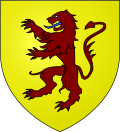House of Mathrafal
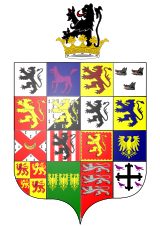
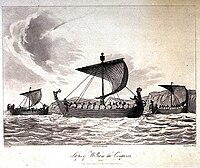

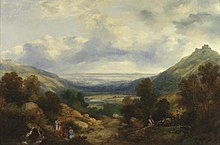
The RoyalHouse of Mathrafalbegan as acadet branchof the Welsh RoyalHouse of Dinefwr,taking their name fromMathrafal Castle.[1][2]They effectively replaced theHouse of Gwertherion,who had been ruling theKingdom of Powyssincelate Roman Britain,through the politically advantageous marriage of an ancestor,Merfyn the Oppressor.[3]KingBleddyn ap Cynfynwould join the resistance of the Anglo-Saxon KingHarold Godwinson,against the invasion ofWilliam the Conqueror,following theNorman conquestof England. Thereafter, they would struggle with thePlantagenetsand the remaining Welsh Royal houses for the control of Wales. Although their fortunes rose and fell over the generations, they are primarily remembered asKings of Powysand last nativePrince of Wales.[4][5]
History[edit]
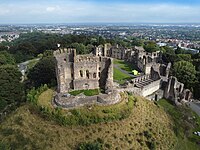
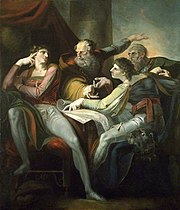
The House of Mathrafal was effectively established in the wake of the Anglo-Saxon King,Harold Godwinson,and his brother,Tostig Godwinson,Earl of Northumbria,and their disastrous raids of 1062–1063 against the King of Wales,Gruffydd ap Llywelyn.[6]They installedBleddyn ap Cynfynas King over Powys and Gwynedd and kept him and his base in Mathrafal close to the Saxon border.[7]Mathrafal Castlebecame their seat and effective capital inPowys,replacing the Roman city ofViroconium.[8]
From this point forward, his family jockeyed with the RoyalHouse of Dinefwrand the RoyalHouse of Aberffrawfor the control of Wales. (The unrelated dynasty in theKingdom of Gwentand theKingdom of Morgannwgwas swiftly overrun by theMarcher Lordsafter theNorman Conquest).
The House of Mathrafal's influence was greatest between 1063 and 1081, until they lost control ofGwyneddto a resurgent Aberffraw family following theBattle of Mynydd Carn.By 1191, the Kingdom of Powys was divided between the Principality ofPowys Fadogin the north and the Principality ofPowys Wenwynwyn(roughly modernMontgomeryshire) in the south.[9]The first became a more-or-less loyal vassal of Gwynedd; the latter, one of its main competitors.
HistorianJohn Daviespoints out that, following the division ofPowys,the dynasty should not be considered as "equal" to that of the RoyalHouse of Aberffrawor the RoyalHouse of Dinefwr.[10]Mathrafal Castle was utterly destroyed by Gwynedd in 1212 and thenceforth it was entirely dependent on English support for its survival. However, the Mathrafal dynasty continued to exert some influence, undermining and eventually betraying the Prince of Wales,Llywelyn ap Gruffudd,on behalf of thePlantagenetKing,Edward Longshanks,during hisConquest of Walesin 1282–83.[11]
Thereafter, they avoided his campaign of extermination against theWelsh Royal Housesand even exchanged their claims to royalty for an English Lordship at theParliament of Shrewsburyin 1283.[12]They were displaced by theLords of Mortimersin the early 14th century, until a momentary reascension of the House during the 15th century, following theWelsh Revoltled by the Prince of Wales,Owain Glyndŵr,againstPrince Henryand KingHenry IV of England,of the RoyalHouse of Lancaster.Glyndwr combined the claims of the Houses of Mathrafal andDinefwr,with links to theHouse of Aberffraw.[13]
Welsh Revolt[edit]
The rebellions were supported by the French RoyalHouse of Valois,and were an attempt not only at gaining the independence of Wales, but also theredivisionof England to their relatives, theHouse of Percyand theMortimers.[14][15]Despite being crowned asOwain IV of Walesin 1404, and having taking control of all Wales, and having created the first Welsh parliament atHarlech Castle,they eventually lost the war to the English forces ofHenry IVandHenry V.[16]
Nonetheless, their efforts didn't go in vain, as their rebellion gave rise to the first Welsh Kings of England, the RoyalHouse of Tudor.[17]The Tudors were their cousins on their mother'sside, through theTudors of Penmynydd,who fought with them during the rebellions, such aSir Owen Tudor,the second husband of QueenCatherine of France.[18]Glyndŵrwas also the wealthiest Welshman in Wales before his downfall in 1415, and captured number of Longshanks’smain castlessuch asConwy,HarlechandBeaumaris,and besiegedCaernarfon.[19][20]
This historic period would later be immortalized byWilliam Shakespearein his playHenry IV, Part 1andPart 2,featuring "Owen Glendower"as a character.[21]The plays depict the wars between his family andPrince Hal,futureHenry V,and other historical events. Other characters featured include his daughter,Lady Mortimer,his son-in-law,Sir Edmund Mortimer,and in-lawsHenry Hotspur PercyandLady Percy.The plays were succeeded by "Henry V'"and are part of Shakespeare'sHenriad.
Succession[edit]
Vaughans of Corsygedol[edit]
The House was succeeded by the descendants of princeOwain Glyndŵrand his brother, lordTudur ap Gruffudd,through the Vaughans ofCorsygedolinSnowdonia,North Wales.[22][23]The Vaughans would become strong supporters of theLancastersduring theWars of the Roses,holdingHarlech Castlefor theTudorsas well as supporting the futureHenry VIIand his uncleJasper Tudor,hiding them atCorsygedolduring their exile to France.[24][25]After the Tudor victory, they were given positions of power such asEsquire of the BodytoHenry Tudor,governor ofCilgerran Castlein Wales, and became one of the official representatives of the Tudor State within the locality under QueenElizabeth I.[26][25][27][28]
They are today represented by its derivative branches; theHouse of Yale(Yale family) and theHughes of Gwerclas,who act as co-representatives of the dynasty.[29][30][31][32][33]They are also the co-representatives of the Sovereign dynasties ofNorth Wales(Gwynedd) andSouth Wales(Dinefwr), havingtheir genealogiestraced back to theRomano-BritishrulerCunedda.[34][35][36][37][38]The Vaughans, Yales, and Hughes of Gwerclas, are also cadet branches of theFitzGerald DynastythroughOsborne Fitzgerald,and direct descendants of thePlantagenets.[39][40][41][42]Their ancestor, lordGerald de Windsor,was anAnglo-Norman,son of the 1st governor ofWindsor CastleforWilliam the Conqueror,and ancestor of the currentDuke of Leinsterin Ireland.[43][44]Notably, he married a Welsh princess namedNesta,daughter of kingRhys ap Tudor,of theHouse of Dinefwr.
TheWynn baronets,who are today represented by theWilliams-Wynns,are related to Mathrafal through theprinces of Aberffrawand theWynne familyof Peniarth, and theJones of Faerdref Uchafthrough theHughes of Gwerclas.[45][46]A descendant, Mary Wynn, daughter of the4th Baronet,marriedRobert Bertie, 1st Duke of AncasterofGrimsthorpe Castle,and passed theWynnstay Estateto her cousin,Sir John Wynn, 5th Baronet.[47]
Ancestry[edit]
Along with the Royal Houses ofAberffraw,Dinefwr,andSeisyll,the House of Mathrafal traced their descent from KingMerfyn the Oppressorwho, along with his son, KingRhodri the Great,established control over northern and western Wales.[48][49]Rhodri replacedKingCyngen ap Cadellas ruler of theKingdom of Powysafter the latter died while on a pilgrimage toRome.[50]His father, Merfyn, had previously allied his family with the last rulers of Powys by marrying PrincessNest,the daughter or sister of King Cyngen.[51][note 1]
In Welsh tradition, her family was of the RoyalHouse of Gwertherion,and had been ruling Powys since the 5th century, through the marriage of an ancestor,Vortigern,the High king, toSevira,the daughter of the Roman Emperor,Magnus Maximus.[54][55][56]Maximus, a relative of the ImperialTheodosian dynasty,is featured on thePillar of Eliseg,erected in the lordship ofYaleby kingCyngen of Powys(b. 790). Itssub-Romancapital was atViroconium,a Roman city that been founded by Caesar'sLegio XIV Gemina,and abandoned later byLegio XX Valeria,for the fortress atDeva Victrix(Chester) duringRoman Britain.[57][58][59]
As a consequence of Merfyn's alliance, King Cyngen's legitimate heirs were either exiled or reduced to the level of minor land owners (e.g., the family ofSir Gruffudd Vychan).[60]Yet, one of the last Kings of Powys,Cadell ap Brochfael,maternal great-grandfather ofBleddyn ap Cynfyn,the first King of the House of Mathrafal, claimed descent from Cyngen's son Aeddan, who seems to have ruled straight after.
Other noble families claimed descent from another of Cyngen's sons,Elisedd,who is mentioned as killing his older brotherGruffyddin theAnnales Cambriae.It is therefore likely that Gwynedd'shegemonyover Powys was merelypropaganda,intended to glorifyGwyneddat the expense of Powys before the time of PrinceOwain Gwynedd.Therefore, there was a lot of political instability as the House had to rule two Kingdoms, Powys and Gwynedd.
In the traditional accounts,Rhodri the Greatdivided his Kingdom among his sons and gavePowysto his youngest, PrinceMerfyn.KingCadellinCeredigionthen dispossessed his brother and added Powys to his inheritance.[61]It is possible, however, that Powys remained independent until its 916 annexation by Cadell's sonHywel Dda,who also conqueredDyfedandGwyneddand established what has become known as the realm ofDeheubarth.On the death of Hywel's grandson in 999,Maredudd ab Owain,the realm splintered: Irishmenusurped Gwyneddandfalsely passedthemselves off as Maredudd's heir in Dyfed. These were removed by KingLlywelyn ap Seisyll,from a cadet branch of the Aberffraw line in thecommoteofRhuddlan.
InWelsh folklore,Mathrafal, as representative of theHouse of Gwynedd,claimed descent through theHarleian genealogiesfromBeli Mawr,an ancestral figure in Welsh royal genealogies, related toCassivellaunus,a historical Celtic king who led the defence againstJulius Caesarduring his secondinvasion of Britainin 54 BC.[62][63][64]InWelsh mythology,starting from Beli Mawr, their genealogies claimed descent in theWelsh TriadsandHistoria Brittonum,written about 828 by Celtic monkNennius,fromBrutus of Troy,the legendaryfounder of Britain,descendant of the Trojan heroAeneas,founder of Rome inGreco-Roman mythology.[65][66]
Members[edit]
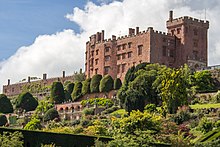
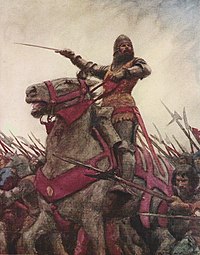
Members of the Mathrafal Dynasty include:[67]
- Bleddyn ap Cynfyn,King of Powys and Gwynedd, joined theAnglo-Saxonresistance with KingHarold Godwinson,of the RoyalHouse of Godwin,againstWilliam the Conqueror
- Gruffydd ap Llywelyn,King of Wales,son-in-law ofÆlfgar, Earl of Mercia,Lady Godiva's son, made an agreement with KingEdward the Confessor,of the RoyalHouse of Wessex,his widow remarried the last Anglo-Saxon kingHarold Godwinson,who died atHastingsfighting againstWilliam the Conqueror
- Rhiwallon ap Cynfyn,King of Powys and Gwynedd, his daughter married the King of Deheubarth,Rhys ap Tewdwr,of the RoyalHouse of Dinefwr,was half-brother of the King of WalesGruffydd ap Llywelyn
- Trahaearn ap Caradog,King of Gwynedd, fought against the King of the Welsh,Gruffudd ap Cynan,of the RoyalHouse of Aberffraw,and the Norman LordRobert of Rhuddlan
- Rhiryd ap Bleddyn,King of Powys, killed at war by the King of South Wales,Rhys ap Tewdwr,of the RoyalHouse of Dinefwr,his father KingBleddyn ap Cynfynwas the founder of Mathrafal
- Cadwgan ap Bleddyn,Prince of Powys, married to a member of theHouse of De Say,companions ofWilliam the Conqueror,was an ally of KingGruffudd ap Cynanagainst theMontgomeries,Norman magnates
- Owain ap Cadwgan,Prince of Powys, he and his father lost lands to KingHenry I of England,was known for his abduction ofPrincess Nest,wife ofGerald de Windsor,of theHouse of FitzGerald[68]
- Iorwerth ap Bleddyn,Prince of Powys, joined the rebellions ofRobert of Bellême, 3rd Earl of Shrewsbury,of theHouse of Bellême,then betrayed him with LordWilliam Pantulf
- Maredudd ap Bleddyn,Prince, later King of Powys, made peace with KingHenry I of England,of the RoyalHouse of Normandy,is featured inBrut y Tywysogionand retired toSnowdonia
- Gruffydd Fychan ap Iorwerth,Marcher Lord,Knight of RhodesandKnight of the Order of Saint John of Jerusalem,fought in theCrusadesunder theKnights Hospitaller,rivals of theKnights Templar,his military order was under the protection ofFrederick Barbarossa,Holy Roman Emperor
- Gwladys ferch Rhiwallon,Queen of Deheubarth, and mother of PrincessNesta,who had a son with KingHenry I of England,son ofWilliam the Conqueror
Last Prince of Powys[edit]
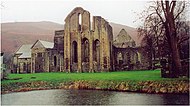
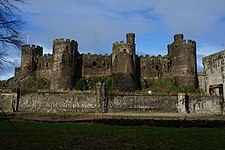
- Madog ap Maredudd,Prince of Powys, fought withRanulf de Gernon, 4th Earl of ChesterofLincoln Castle,for the Holy Roman EmpressMatilda,against the King of England,Stephen of Blois,of the RoyalHouse of Blois
- Gruffydd Maelor I,Prince of Powys Fadog, Lord ofYale,married to PrincessAngharad,daughter of the 1st Prince of Wales,Owain Gwynedd,of the RoyalHouse of Aberffraw
- Madog ap Gruffydd Maelor,his son, Prince of Powys Fadog, bore the Black Lion, built the religious center ofValle Crucis Abbeyin the lordship ofYale,was grandson of the 1st Prince of Wales,Owain Gwynedd,cousin of PrinceLlywelyn ab Iorwerth,and ally of KingJohn PlantagenetofMagna Carta
- Owain Fychan,Lord of Mechain Is Coed, capturedCarreghofa Castle,lost it to KingHenry II of England,of the RoyalHouse of Angevin,then took it back
- Owain Brogyntyn,Lord of Edeirnion, Lord of Dinmael, ofCastle Brogyntyn,confirmed Baron by KingEdward Longshanks,of the RoyalHouse of Plantagenet,under the terms of theStatute of Rhuddlan
- Marared ferch Madog, mother of the Prince of North Wales and Lord ofSnowdonia,Llywelyn the Great,and was married toIorwerth ab Owain Gwynedd,of the RoyalHouse of Aberffraw
- Efa ferch Madog, married to thePrince of Maelienydd,Cadwallon ap Madog,the great-grandson of the Prince of Buellt, who founded one of theFive Royal Tribes of Wales
- Gwenllian ferch Madog, daughter of PrinceMadog ap Maredudd,ancestress of theTudors,was married toLord Rhys,Prince of Wales, who fought and captured many castles ofRichard the Lion Heart
- Gwenwynwyn ab OwainCyfeiliog, Ruler of Mid Wales, made an agreement with KingRichard the Lionheart,of the RoyalHouse of Plantagenet
- Gruffydd ap Gwenwynwyn,Welsh King and Prince of Powys Wenwynwyn, married toHawise,daughter ofMarcher LordJohn Lestrange,whose father John II joined theThird CrusadeagainstSaladin[69]
- Owen de la Pole,Lord of Powys, family lost their Principality to KingEdward Longshanksduring hisConquest of Wales,his aunt wasLady Isabella,Queen of Cyprus of theHouse of Ibelin,and great-great-granddaughter ofBalian of Ibelin,who famously defended and surrenderedJerusalemtoSaladin
- Hawys Gadarn,mother of LordCharlton,he was married to a daughter ofRoger Mortimer, 1st Earl of March,who was the great-grandson ofJohn of Brienne,King of Jerusalem andEmperor of Constantinople
- Griffith de la Pole,Lord of Powys,was the uncle of LordCharlton,who was married to a granddaughter ofJoan of Lusignan,member of the RoyalHouse of Lusignan
- John Charlton, 3rd Baron Charlton,married to a daughter of theEarl of Stafford,his family included the Duke ofBuckingham,Lancaster,Gloucester,andBavariaof the RoyalHouse of Wittelsbach
- Gruffudd Fychan I,Prince of Powys Faddog,Lord of Yale,Edeirnion and Glyndyfrdwy, great-grandfather of PrinceOwain Glyndŵrand LordTudor Glendower,lost theLordship of Bromfield and Yaleto the Guardian of Scotland,John de Warenne,the Commander defeated byWilliam Wallaceat theBattle of Stirling Bridge[70]
- Gruffudd Fychan II,Prince ofPowys Fadog,married to a great-granddaughter ofEleanor Plantagenet,the daughter of KingEdward Iand QueenEleanor of Castileof the RoyalHouse of Ivrea[71]
- Eleanor ap Thomas, wife of PrinceGruffudd Fychan II,father was Lord ofSouth Wales,her cousins and in-laws included the Royal houses ofHabsburg,Gonzaga,Lorraine,Valois,andSavoy
- Owain Glyndŵr,Prince of Wales, hereditary Prince of Powys Fadog, married to PrincessMargaret Hanmer,daughter of SirDavid Hanmer,started theWelsh Revolt,was the wealthiest Welshman in Wales[72]
- Tudor Glendower,Lord of Gwyddelwern, brother of the Prince of Wales and cousin of theTudors,fought againstPrince Henry,of the RoyalHouse of Lancaster,during theWelsh Revolt
- Lowry ap Gruffudd, his sister, was married toRobert Puleston,their son heldDenbigh Castlefor his cousinJasper Tudor, Duke of Bedford,of the RoyalHouse of Tudor,during theWars of the Roses
- John Charlton, 4th Baron Charlton,family included DuchessElizabeth FitzAlan,ancestress of QueenAnne Boleyn,andBeatrice,daughter of KingJohn I of Portugalof the RoyalHouse of Aviz
- Edward Charlton, 5th Baron Charlton,married toAlianore Holland,in-law ofLord Viscontiof Milan, niece of KingRichard II,great-grandmother of KingEdward IVandRichard III,of the RoyalHouse of York
- Maredudd ab Owain Glyndŵr,son of the Prince of Wales, fought in theWelsh Revolt,was later pardoned by KingHenry V of England,of the RoyalHouse of Lancaster
- Catrin ferch Owain Glyndŵr,married toSir Edmund Mortimer,the great-nephew ofEdward the Black Princeand PrinceJohn of Gaunt,Duke of Lancaster and richest man in England, was cousin of KingHenry IV of England,and great-grandson of KingEdward of Windsorand QueenPhilippa of Hainault[73]
- Lowrie ap Tudur, heiress of her father LordTudor Glendower,and uncleOwain Glyndŵr,Prince of Wales, inherited the co-representation of the Sovereign dynasties ofPowys(Mathrafal),North Wales(Gwynedd) andSouth Wales(Dinefwr), married Griffith ap Einion of theFitzgerald dynastyof Corsygedol[74]
- Ellis ap Griffith(Elissau ap Gruffudd), her son, Baron ofGwyddelwern,grandson of LordTudor Glendower,heir by marriage of Allt Llwyn Dragon (renamed Plas-yn-Yale),[75][76][77]founder of theHouse of Yale,grandfather of ChancellorThomas Yaleand great-grandfather of ChancellorDavid Yale,the great-grandfather of Gov.Elihu Yale,benefactor ofYale University[78][79][80][81]
Notes[edit]
- ^The view that Ethyllt was Merfyn's mother and Nest his wife is held byDavies[52]and many others, including David E. Thornton[51]andLloyd,[53]who notes the consistency of the genealogies inJesus College MS 20 from Oxford universityandHarleian MS 3859against the contrary account that Nest was the mother and Ethyllt the wife. Thornton gives Nest as Cadell's sister.[51]
References[edit]
- ^Ulwencreutz, Lars (2013).The Royal Families in Europe V: A Brief History of the Ruling Houses During The Last 2000 years,From the House of La Tour d'Auvergne to the House of Zähringen, p. 50
- ^The Houses of Cunedda and Rhodri Mawr,Welsh Medieval Law: The Laws of Howell the Good (1909) by Hywel ap Cadell, translated by Arthur Wade Wade-Evans.
- ^Lloyd, John Edward (1911),A History of Wales from the Earliest Times to the Edwardian Conquest,vol. I (2nd ed.), London: Longmans, Green, and Co (published 1912), p. 323-325
- ^"RCAHMW: In the steps of Owain Glyndwr".rcahmw.gov.uk.Royal Commission on the ancient and historical monuments of wales.Retrieved2022-10-31.
- ^Shakespeare’s Princes of Wales,England’s Hope? Shadowed Heirs in Shakespeare’s Histories, Oxford Academic, Marisa R. Cull, 2014, p.52–82
- ^Chapter Twenty-One, Wales and West Britain, John Reuben Davis, page 346
- ^A Companion to Britain in the Early Middle Ages: Britain and Ireland c. 500–1100, edited by Pauline Stafford (Oxford: Blackwell, 2009), pp. 341–357
- ^Davies, John (1990). History of Wales. Penguin.
- ^Ulwencreutz's The Royal Families in Europe V, page 50-51
- ^Davies, John (2007).History of Wales.Penguin Books.
- ^Chapter Twenty-One, Wales and West Britain, John Reuben Davis
- ^Ulwencreutz's The Royal Families in Europe V, page 51
- ^Davies 1990,p.194.
- ^Owen Glendower (Owen Glyn Dŵr). By J. E. Lloyd. 9 × 6. Pp. xiv + 161. Oxford: at the Clarendon Press, 1931. 10s. 6d.
- ^Biography.Wales, Owain Glyndwr (c. 1354 - 1416), 'Prince of Wales'
- ^Biography.Wales, Owain Glyndwr (c. 1354 - 1416), 'Prince of Wales'
- ^The History Press, Three things you might not know about Owain Glyndŵr
- ^The History Press, Three things you might not know about Owain Glyndŵr
- ^The National Library of Wales, Pennal Letter: Wales’ important role in European politics
- ^A.D. Carr (1995)."Medieval Wales, British History in Perspective, Chapter 46: Rebellion and Revenge".Palgrave, London. pp. 108–132.doi:10.1007/978-1-349-23973-3_6.
- ^Davies 1990,p.195.
- ^Burke, Bernard (1852)."A genealogical and heraldic dictionary of the landed gentry of Great Britain & Ireland for 1852".pp. 1662–1663.
- ^"The Royal Families of England, Scotland, and Wales, with Pedigrees of Royal Descents in Illustration"(PDF).Sir Bernard Burke, C.B., LL.D., Ulster King of Arms. 1876. p. 51.
- ^Lloyd, Jacob Youde William (1887)."The History of the Princes, the Lords Marcher, and the Ancient Nobility of Powys Fadog, and the Ancient Lords of Arwystli, Cedewen, and Meirionydd".Whiting & Co. pp. 1–4–386–389.
- ^abCorsygedol: A Brief History,The Institute for the Study of Welsh Estates, Bangor University, Shaun Evans, 2017, p. 13-14
- ^Vaughan Family of Wales,B. H. J. Hughes, 1999, p. 12
- ^Lloyd, Jacob Youde William (1887)."The History of the Princes, the Lords Marcher, and the Ancient Nobility of Powys Fadog, and the Ancient Lords of Arwystli, Cedewen, and Meirionydd".Whiting & Co. pp. 1–4–386–389.
- ^Davies, W. Ll., (1959). VAUGHAN family of Corsygedol, in the parish of Llanddwywe, Meironnydd. Dictionary of Welsh Biography. Retrieved 3 Nov 2023, fromhttps://biography.wales/article/s-VAUG-COR-1250
- ^Henry Whittemore (1897)."The Heroes of the American Revolution and their Descendants".The Heroes of the Revolution Publishing Co. p. 112.
- ^Burke, Bernard (1852)."A genealogical and heraldic dictionary of the landed gentry of Great Britain & Ireland for 1852".pp. 1662–1663.
- ^Encyclopædia of Heraldry: Or General Armory of England, Scotland, and Ireland,John Burke, 3rd Edition, London, 1844
- ^Burke, Bernard (1886)."A Genealogical and Heraldic History of the Landed Gentry of Great Britain & Ireland".pp. 2060–2061.
- ^The History of the State of Rhode Island and Providence Plantations,Biographical, The American Historical Society, New York, 1920, p. 51-52
- ^The History of the State of Rhode Island and Providence Plantations,Biographical, The American Historical Society, New York, 1920, p. 51-52
- ^Burke, Bernard (1852)."A genealogical and heraldic dictionary of the landed gentry of Great Britain & Ireland for 1852".pp. 1662–1663.
- ^David Jones, ‘Wales and the Crown’, 1953, in Epoch and Artist: Selected Writings, ed. Harman Grisewood, London: Faber & Faber, 1959, pp. 41–2.
- ^Bridging the Breaks: David Jones and the Continuity of Culture, by Jasmine Hunter-Evans
- ^Henry Whittemore (1897)."The Heroes of the American Revolution and their Descendants".The Heroes of the Revolution Publishing Co. p. 112.
- ^Burke, Bernard (1852)."A genealogical and heraldic dictionary of the landed gentry of Great Britain & Ireland for 1852".pp. 1662–1663.
- ^Burke, Bernard (1886)."A Genealogical and Heraldic History of the Landed Gentry of Great Britain & Ireland".pp. 2060–2061.
- ^Henry Whittemore (1897)."The Heroes of the American Revolution and their Descendants".The Heroes of the Revolution Publishing Co. p. 112.
- ^Encyclopedia of Connecticut Biography, Genealogical-Memorial, Representative Citizens,The American Historical Society Publishers, 1917. Vol. 7, Chicago, p. 95-96
- ^Burke, Bernard (1852)."A genealogical and heraldic dictionary of the landed gentry of Great Britain & Ireland for 1852".pp. 1662–1663.
- ^Philip Yorke (1887)."The royal tribes of Wales; To which is added an account of The fifteen tribes of north Wales. With numerous additions and notes, preface and index".Liverpool I. Foulkes. pp. 16–17.
- ^"Wynne family, of Peniarth".archives.library.wales.Retrieved2022-10-24.
- ^D. JONES (Chemist and Bookseller, Barmouth.) (1863)."The Tourist's and Visitor's Hand-Book and Guide to Harlech, Barmouth, Dolgelley, Towyn..."pp. 34–35.Retrieved2022-10-29.
- ^Roberts, G., (1959). WYNN family, of Gwydir, Caernarfonshire. Dictionary of Welsh Biography. Retrieved 14 Aug 2023, fromhttps://biography.wales/article/s-WYNN-GWY-1300
- ^Lloyd, John Edward (1911),A History of Wales from the Earliest Times to the Edwardian Conquest,vol. I (2nd ed.), London: Longmans, Green, and Co (published 1912), p. 323-325
- ^Chapter Twenty-One, Wales and West Britain, John Reuben Davis
- ^Ulwencreutz's The Royal Families in Europe V, page 50
- ^abcThornton 2004
- ^Davies 1990:81,A History of Wales
- ^Lloyd 1911:324,A History of Wales, Vol I
- ^Bartrum., Peter Clement (1993).A Welsh Classical Dictionary; People In History And Legend Up To About A. D. 1000.The National Library of Wales.ISBN9780907158738.Retrieved2022-11-08.
- ^L. Reno, Frank (2014).Arthurian Figures of History and Legend: A Biographical Dictionary.McFarland.ISBN978-0-7864-5824-0.RetrievedAugust 15,2022.
- ^Laycock, Stuart (2011).Warlords: The Struggle for Power in Post-Roman Britain.The History Press.ISBN978-0-7524-7560-8.RetrievedAugust 15,2022.
- ^Assessment of Wroxeter,Shropshire, Roger White and Hal Dalwood
- ^Oxford Classical Dictionary, Viroconium, Sheppard S. Frere and Martin Millett
- ^As Told in the Great Hall: The Wargamer's Guide to Dark Age Britain, Martin Hackett
- ^Ulwencreutz's The Royal Families in Europe V, page 50
- ^Chapter Twenty-One, Wales and West Britain, John Reuben Davis
- ^Nicholson, E. Williams B. (1908)."The Dynasty of Cunedag and the 'Harleian Genealogies'".London:Honourable Society of Cymmrodorion.pp. 63–67–105.
- ^Anscombe, A. (1898), "Indexes to Old-Welsh Genealogies (continuation)",in Stokes, Whitley; Meyer, Kuno (eds.), Archiv für celtische Lexikographie, vol. II, Halle: Max Niemeyer (published 1904), pp. 58-60
- ^GUY, BEN. “THE PEDIGREES OF THE KINGS OF GWYNEDD.” Medieval Welsh Genealogy: An Introduction and Textual Study,NED-New edition, Boydell & Brewer, 2020, pp. 233–64. JSTOR. Accessed 26 May 2023.
- ^White, David John (2022).The Matter of Britain: How the Tudors Adapted British Historic Tradition to Legitimise their Dynasty,Graduate Program in History, Queen’s University, Ontario, p. 2-31-32
- ^Jones, Arthur (1910).The history of Gruffydd ap Cynan; the Welsh text,Publications of the University of Manchester, Historical Series, No. IX, Cornell University Library, p. 34-37
- ^Ulwencreutz, Lars (30 October 2013).Ulwencreutz's the Royal Families in Europe V.ISBN9781304581358.
- ^Brut y tywysogion: Or, The chronicle of the princes A.D. 681–1282 (Great Britain. Public Record Office. Kraus Reprints: 1965, ASIN: B0007JD67I
- ^Bodleian, MS Ashmole 1120, fo. 174r
- ^The baronage of England, or, An historical account of the lives and most memorable actions of our English nobility in the Saxons time to the Norman conquest,University of Michigan, Dugdale, William, Sir, 1605-1686.
- ^"The Royal Families of England, Scotland, and Wales, with Pedigrees of Royal Descents in Illustration"(PDF).Sir Bernard Burke, C.B., LL.D., Ulster King of Arms. 1876. p. 51.Retrieved2022-10-02.
- ^A.D. Carr (1995)."Medieval Wales, British History in Perspective, Chapter 46: Rebellion and Revenge".Palgrave, London. pp. 108–132.doi:10.1007/978-1-349-23973-3_6.
- ^Goodman, A. (1992). John of Gaunt: The Exercise of Princely Power in Fourteenth-Century Europe (1st ed.). Routledge.https://doi.org/10.4324/9781315844411
- ^Burke, Bernard (1852)."A genealogical and heraldic dictionary of the landed gentry of Great Britain & Ireland for 1852".pp. 1662–1663.
- ^Lloyd, Jacob Youde William (1887)."The History of the Princes, the Lords Marcher, and the Ancient Nobility of Powys Fadog: And the Ancient Lords of Arwystli, Cedewen, and Meirionydd".London, T. Richards. pp. 1–4.
- ^"Archaeologia Cambrensis (1846-1899), Yale, and Chirkland".Welsh Journals - the National Library of Wales. 1877. p. 101.
- ^Encyclopedia of Connecticut Biography, Genealogical-Memorial, Representative Citizens,The American Historical Society Publishers, 1917. Vol. 7, Chicago, p. 95-96
- ^Burke, Bernard (1882)."A Genealogical and Heraldic History of the Landed Gentry of Great Britain & Ireland".p. 1806.At the bottom of the page, on the right
- ^Arthur Herbert Dodd (1959)."YALE family, of Plâs yn Iâl and Plas Grono Wrexham".Dictionary of Welsh Biography.
- ^Thomas Nicholas (1872)."Annals and Antiquities of the Counties and County Families of Wales".Longmans, Green, Reader, and Co. p. 419.
- ^The History of the State of Rhode Island and Providence Plantations,Biographical, The American Historical Society, New York, 1920, p. 51-52
- Lewys Dwnn Heraldic Visitations of Wales and Part of the Marches between the years 1586 and 1613
Sources[edit]
- Davies, John (2007).History of Wales.Penguin Books. London
- "MERFYN FRYCH (died 844), king of Gwynedd".Dictionary of Welsh Biography.National Library of Wales.
- Davies, John(1990),A History of Wales(First ed.), London: Penguin Group (published 1993),ISBN0-7139-9098-8
- Lloyd, John Edward(1911),A History of Wales from the Earliest Times to the Edwardian Conquest,vol. I (2nd ed.), London: Longmans, Green, and Co (published 1912)
- Thornton, David E. (2004), "Merfyn Frych (d. 844)",Oxford Dictionary of National Biography,Oxford University Press
- Jones, Owain (2013),Historical writing in medieval Wales,Bangor University

